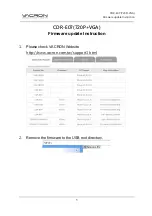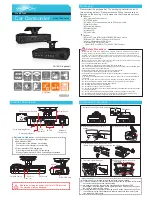
10
All parts (Figs. 1-5):
B
Screen module
C
LCD monitor
D
Tube
E
Lens turret
F
Objective
G
Slide (here: prepared slides)
H
Microscope table
I
Collector lens
J
LED lighting (transmitted light)
1)
Microscope foot
1!
Operating light
1@
On/ off switch for screen module
1#
LED top illumination (only for use with 4x objective)
1$
Stage
1%
Colour filter plate
1^
Focusing wheel
1&
Power connection
1*
Dimmer
1(
Lighting selector switch
2)
Input keys
2!
Photo button
2@
Menu key
2#
Change key
2$
Vernier scales
2%
Clamping screw
2^
Stage drive forwards/back
2&
Stage drive left/right
2*
Levers for clamping mounting plate
2(
Mounting plate clamp
3)
Clear aperture (without colour filter)
3!
Colour filter
3@
USB cable
3#
Box with 10 slides, 10 covers and 5 prepared slides
3$
A) Microscope utensils; B) Pipette; C) Tweezers
3%
Shrimp breeding enclosure
3^
Mikrotom tissue chopper
3&
Preparations: A) Yeast; B) Gum Arabic Media ; C) Sea salt;
D) Shrimp eggs
3*
Power supply plug
1. Location, connection types
Before you begin with the assembly of your microscope, you
must select a suitable location.
First you should ensure that your microscope is set up on a sta-
ble, vibration-free surface.
Power connection (220-230 V) is required for observations using
the electrical LED lighting and the electronic LCD eyepiece
(screen module).
Furthermore the microscope possesses an interface to a PC
(USB connection).
2. Start-up, electrical LED lighting
Before start-up, please check that the lighting selector switch
(Fig. 1.19) is in the “OFF position“.
The microscope is equipped with two LED lighting units. The
lighting can take place in three ways. At the selector switch (Fig.
1.19) select position “I”, in order to illuminate the object from un-
derneath (with transmitted light), or “II “,to illuminate it from above
(with top illumination). With position “III” the object can be illumi-
nated from above and below at the same time. The transmitted
light unit (Fig. 1.9) is used for transparent preparations (prepara-
tions on glass slides). In order to see solid, non-transparent ob-
jects, select the top illumination unit (Fig. 1.13). The top
illumination unit is only useful when using the 4x- objectivee. The
use of both lighting at the same time is only useful with semi-
transparent objects. This mode of operation is not recommended
for transmitted light objects on slides, as this can lead to reflec-
tions on the slides.
To start-up, the power supply plug, which is provided, (Fig. 5.38)
is connected to the power connection (Fig. 1.17) at the rear of
the microscope foot (Fig. 1.10) and to a convenient outlet (220-
230 V). Finally, switch on the desired lighting using the lighting
selector switch and set the required brightness with the
dimmer (Fig. 1.18). Since your equipment is fitted with infinitely
variable lighting (dimmer), the optimum illumination of the object
to be observed is ensured.
3. Observation
3.1 Microscope observation in general
Once you have assembled the microscope and appropriately ad-
justed the illumination, the following principles apply:
a) Begin each observation with the lowest magnification, thus
centring and positioning of the object to be observed will be ea-
sier.
Move the microscope table(Fig. 1.7),using the focusing wheel
(Fig. 1.16) completely down and then turn the lens turret (Fig.
1.4) until it engages on the lowest magnification (the 4x-objective
is vertical).
b) Begin with a simple observation. Place a prepared slide (Fig.
1+3.6) directly under the objective on the microscope table (Fig.
1+3.7), by clamping it into the stage (Fig. 1+3.14). For this, move
the lever for the clamping mounting plate (Fig. 3.28) to the side,
put the prepared slide onto the stage and carefully allow the
Note:
An SD-Memory Card is required to store your recordings
(not included in delivery).











































